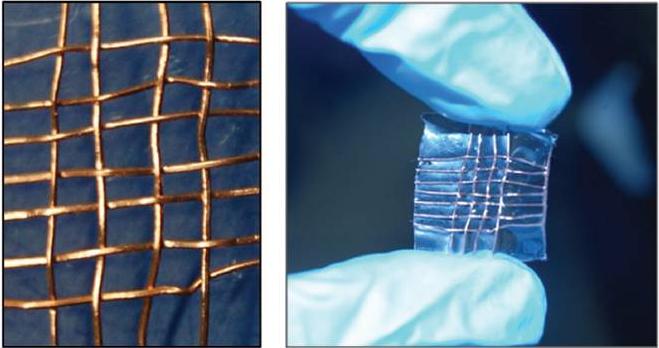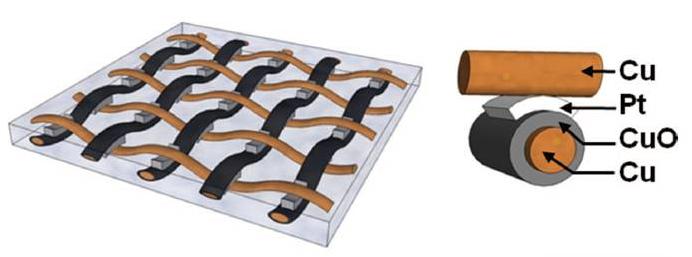Smart clothing: memory-storing fiber could lead to smart fabrics and wearable electronics
September 27, 2011

Is this the new smart fabric? No, it's a prototype, but give it some funding and a few years ... (credit: NASA)
Scientists at the Center for Nanotechnology at NASA Ames Research Center have developed a new flexible memory fabric woven together from interlocking strands of copper and copper-oxide wires. It may soon enable smart fabrics and wearable electronics.

At each juncture (stitch) along the fabric, a nanoscale platinum (Pt, gray) electrode is placed between the copper-wire (Cu) coating (CuO, black), which serves as a semiconductor/resistive storage medium, and the copper (Cu) wire (orange), which is used electrode and mesh structure. Each cross point can assume either an insulating or conducting state depending on the applied voltage, forming a resistive switching memory circuit. (Credit: NASA)
This design easily lends itself to textiles because it naturally forms a crossbar memory structure where the fibers intersect. The researchers developed a reversible, rewritable memory system that was able to retain information for more than 100 days. In this proof-of-concept design, the copper wires are one-millimeter thick; smaller-diameter wire would allow for an increase in memory density and reduction in weight.
In practical applications, e-textiles would need to integrate a battery or power generator, sensors, and a computational element, as well as a memory structure. Besides cool wearable electronic gadgets, an e-textile could potentially detect biomarkers for various diseases or monitor vital signs of the elderly or individuals in hostile environments, and then transmit that information to doctors.
How would this compare to flash memory? The storage density is determined by the number of cross points. “If the wire diameter and inter-wire spacing can be aggressively scaled down to 50 nm, 100,000 wires can be located in 1 cm, implying that a 1 cm x 1 cm area of the textile would contain 10 billion cross points (10 Gb), a density corresponding to approximately 2000 MP3 songs,” according to NASA scientists Jin-Woo Han and M. Meyyappan. “Further scaling to nanoscale in the future could dramatically increase the memory density.”
Ref.: Jin-Woo Han and M. Meyyappan, Copper oxide resistive switching memory for e-textile, AIP Advances, 2011; [DOI:10.1063/1.3645967] (open access)